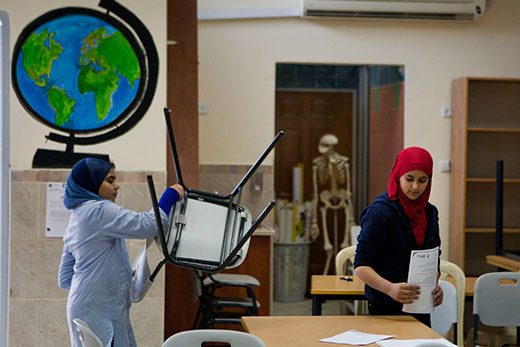‘Israel Apartheid Week’ is looming on campuses worldwide. In fact, as this edited extract from a new ebook shows, Israel has done better in evening out the differences between its Jewish and Arab citizens than most countries encompassing sharply diverse nationalities.Liberal Oasis: The Truth About Israel is available online from Encounter Books.
When the intifada erupted in 2000, Jewish Israelis were shocked when some of their Arab countrymen joined in the violence, blocking roads and rioting until suppressed by the police with lethal force. By the time peace was restored, one Jew and thirteen Arabs had died. This prompted the government to create a three-person investigatory commission, chaired by Supreme Court justice Theodor Or and including an Arab judge, Hashim Khatib. While criticising the police for excessive force and Arab community leaders for incitement, the commission’s report homed in on the problem of inequality: ‘Government handling of the Arab sector has been primarily neglectful and discriminatory. The establishment did not show sufficient sensitivity to the needs of the Arab population, and did not take enough action in order to allocate state resources in an equal manner. The state did not do enough or try hard enough to create equality for its Arab citizens or to uproot discriminatory or unjust phenomenon.’1
Since then, liberal Jewish and Arab-Israeli NGOs have monitored government efforts to promote greater equality. While they consistently find that not enough has been done or that the results have not been sufficient, nonetheless, Israel has done better in evening out socioeconomic differences than most countries encompassing sharply diverse nationalities.
Consider first health, the best summary measurement of which may be life expectancy. This is higher for Jews than for Arabs in Israel, but not by much. For Jews, the numbers are 83.9 years for women and 80.7 for men. Among Israeli Arabs the number is 80.9 for women and 76.5 for men.2 According to a study released in 2010 by Ben-Gurion University, the most recent data put the life expectancy of Israeli Arabs overall at 79 years, which is two years less than that of Israeli Jews, but one year more than that of Americans.3 This is also almost ten years longer, according to UN statistics, than the life expectancy of the Arab world as whole, and longer than for any individual Arab country except Lebanon.4
The other main measure of public health is infant mortality. Sikkuy, The Association for the Advancement of Civic Equality, an Israeli advocacy group, reports ‘a large gap in infant mortality between Jews and Arabs: 3.2 vs. 8.0 per thousand live births, respectively.’5 Sikkuy’s report acknowledges that the figure for Arabs is driven upward by the Bedouin whose rate is 13 per thousand and is due largely to factors that are not easy for the state to control, to wit, ‘The main reason for infant mortality among the Negev Bedouin is birth defects and hereditary diseases.’ Other data show that Israeli Arabs are far less likely than Jews to submit to prenatal testing of fetuses which presumably means that Jews are more likely to abort abnormal fetuses which also happen to be at higher risk of infant death.
Without further exploring factors that may help explain the Jewish/Arab disparity, perhaps the more important point is that in the range of country scores for infant mortality, both are low numbers. The 8-per-thousand deaths suffered by Arab Israeli newborns is not much worse than for all babies born in the United States, where the number is judged by the World Bank to be 6.8 and was projected by the CIA to be 6.14 in 2010. Or, to consider the global picture, the Arab Israeli figure of 8 is less than half of the global median of around 17 deaths per thousand.
Education is another area in which Jewish Israelis show statistical advantages over their Arab countrymen, but again the differences are not large. Classroom size is perhaps the area of greatest disparity and the hardest to excuse since this would seem to lie well within the power of the state to control. The average elementary school class in Jewish areas, according to Sikkuy, has 24.6 students while the average in Arab areas has 29. For high schools, it is 27.6 students in Jewish areas and 30.5 in Arab.
There are also disparities in educational attainments. The median number of years of schooling completed is 12.7 for Jews as against 11.1 for Arabs.6 Surely, to at least some degree this reflects the well-known Jewish mania for education. (Perhaps amusingly, the greatest statistical disparity in education between Arabs and Jews in Israel is for school enrollment of two-year-olds.7 Of course this is due largely to the greater participation of Jewish women in the labor force. But it probably also owes something to Jewish obsessions.)
It turns out, thus, that the gap in educational attainment between Jews and Arabs in Israel pales in comparison to the gap between Jews and gentiles in the United States (where, it may be recalled, out-and-out discrimination against Jews was practiced only a few generations ago). According to the Pew U.S. Religious Landscape Survey in 2008, 59 per cent of Jews in America had a college degree and 35 per cent had postgraduate education. Pew did not ask the exact number of years of schooling, but we may safely infer from these numbers that the Jewish median is not lower than 17 (although it may be higher). For Americans as a whole, the Pew data suggest that the median is 12, since 50 per cent of Pew’s respondents said that they had nothing more than a high school diploma or less. (And because Jews raise the overall average somewhat, the median for non-Jewish Americans must be slightly below 12.) In short, estimating conservatively, we can calculate that Jews in America have on average 40 to 50 per cent more education than gentiles; whereas in Israel Jews have only 14 per cent more education than Arabs.
A half century ago, Arabs everywhere in the Middle East had very little education, whether due to values in their own culture or to the contemptuous treatment they received at the hands of colonial rulers. Significant gains have been recorded throughout the region, and those in Israel are especially impressive. According to the Israel Democracy Institute, ‘between 1961 and 2007, the average numbers of years of schooling [of Israeli Arabs] rose from 1.2 to 11.3, which signifies a more than nine fold increase.’8 How many countries or groups anywhere have recorded such dramatic progress? The IDI paper did not give a figure for Israeli Jews for comparison, but [other] data show that the overall mean for Israel rose from 7.3 to 11.9. This means that the gains among Israel’s Jewish population were far smaller than among its Arabs.
In sum, while some educational disparity endures between Israeli Jews and Arabs, the most remarkable facts about this disparity are the astonishing rate at which it has diminished and that it is smaller than the disparity between Jews and non-Jews outside of Israel. It is testament more to Israel’s egalitarianism than to inequality.
Now let us turn to economic issues. In Israel, according to 2008 data, unemployment among Arab men was 10.3 per cent and for Jewish men, 8.2 per cent.9 The disparity among women was greater, 14 per cent to 9.6 per cent. Since there were far fewer women in the work force, the combined rate would be closer to the rate for males. Unemployment rates are constantly changing, and I have seen other figures with somewhat greater differences, on the ratio of 3 to 2, although since 2008 unemployment has been dropping in Israel across the board which is likely to have narrowed the disparity somewhat. In any case, these numbers compare favorably with available data for Europe (where I can find no statistics for Arabs but rather for Muslims or specific national subgroups).
If the differences between Jewish and Arab Israelis in unemployment rates are rather small, the differences in income are rather large. According to the Organisation for Economic Cooperation and Development (OECD), the net income of Arab households is 63 per cent that of Jewish households.10 In part this disparity is explained by the much higher participation of Jewish women in the labor force: 68 per cent as opposed to only 22 per cent for Arab women in Israel.11 In part, too, it is a function of the higher earning of Jews. On average, an Arab worker makes 70 per cent of a Jewish worker, on an hourly basis and 68 per cent monthly.12 Some of this disparity is accounted for by the higher level of education among Jews, even though that gap is modest, some by Hebrew language deficiencies, some by the exclusion of Arabs from the networking opportunities afforded by military service, and some, no doubt, by discrimination.
However much weight may be attributed to each of these causes, George Gilder casts a light on the import of this disparity with this arresting point: ‘The prowess of Jewish entrepreneurs and other professionals … produces similar gaps in every free country on earth with significant numbers of Jews. Jews, for example, outearn other Caucasians in the United States by an even larger margin than they out-earn Arabs in Israel.’13
If Arab household income is 63 per cent of that of Jews, it means that Arab per capita income is even lower since the average Arab household is about 50 per cent larger. Roughly, therefore, Arab income per person in Israel is only about 40 per cent of that of Jews. That is a large disparity, but some cross-country comparisons add context. Using the IMF’s World Economic Outlook Database estimates for the year 2013, I have calculated the per capita income of the Arab countries as a group, and it comes out to just over $10,000 (measured in Purchasing Power Parities). The same source gives the estimated per capita income of Israelis as just under $35,000. If Arab per capita income in Israel is forty per cent that of Jews, then we can estimate that Arab income in Israel is $15,000 per capita. That means it is half-again as high as the income of Arabs in Arab countries.
Notes
1 Official Summation of the Or Commission Report, printed in Haaretz Online English, September 2, 2003.
2 Government of Israel, Central Bureau of Statistics, Statistical Abstract of Israel.
http://www1.cbs.gov.il/reader/shnaton/templ_shnaton_e.html?num_tab=st03_24&CYear=2010 Accessed May 15, 2013.
3 American Associates Ben-Gurion University of the Negev, ‘Life Expectancy Higher in Israel than in the United States,’ News release, 12 October, 2010.
4 ‘Life Expectancy at Birth, Total (Years),’ UN Data http://data.un.org/Data.aspx?d=WDI&f=Indicator_Code%3ASP.DYN.LE00.IN#WDI
Data for the most recent year available, 2011, accessed 21 November, 2013.
5 Ali Haider, Yaser Awad, and Manar Mahmoud, The Equality Index of Jewish and Arab Citizens in Israel, Jerusalem & Haifa: Sikkuy, The Association for the Advancement of Civic Equality, November 2009, p. 23.
6 Yaser Awad and Manar Mahmoud, The Equality Index of Jewish and Arab Citizens in Israel,
Haifa: Sikkuy – The Association for the Advancement of Civic Equality, 2009, p. 46.
7 Ibid, p. 44.
8 Yosef Jabareen, Team Leader, ‘18th Caesarea Forum – The Employment of Arabs in Israel,’ 16 June 2010.
9 Haider Awad and Mahmoud, op cit, p. 52.
10 OECD, Labour Market and Socio-Economic Outcomes of the Arab-Israeli Population, OECD Social, Employment And Migration Working Papers No. 102, 18 March 2010, p. 32, http://www.oecd.org/officialdocuments/displaydocumentpdf?cote=DELSA/ELSA/WD/SEM%282010%292&doclanguage=en
11 Ibid., p. 22.
12 Ibid, p. 28.
13 George Gilder, The Israel Test, Minneapolis: Richard Vigilante Books, 2009,
Kindle edition, location 695.






































Comments are closed.